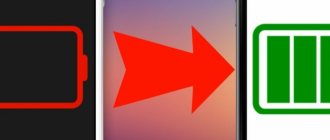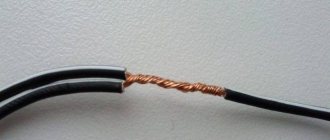Any motorist may find himself in such conditions when the car’s battery suddenly stops working, and there is no way to charge it from a conventional charger. For example, if the car has not been used for a long time and has been parked for several months, the battery will gradually discharge and stop working. In addition, if you leave the headlights on, the battery will run out very quickly overnight, and you simply won’t be able to start the car. In such cases, you should know how to charge the battery without a charger, using methods known to many drivers.
Determining the reason: diagnostics
If the car does not start, you should first find out exactly whether the reason lies in the battery. First you need to pay attention to the dashboard. If the indicators on it light up dimly or don’t light up at all, it means the battery is definitely dead. It’s good to have a voltmeter built into the dashboard: in this case, a sharp drop in voltage readings will indicate a problem with the battery.
It is also necessary to inspect the car battery itself. All modern batteries are equipped with a charging indicator, by the color of which you can tell whether the battery is low or not. When the indicator lights up red, that means it is so.
If the battery is dead, this will also affect the sound of the engine. The sound will be weak, more monotonous and very viscous, with a characteristic clicking sound under the hood. If any of these signs are suddenly detected, you will have to think about how to charge the car if there is no charge, showing a certain amount of ingenuity and sociability.
Final discharge voltage
A VRLA battery cannot be discharged to zero. It is common to see a cut-off voltage specification of ~10.5V for a "12V" battery (1.75V/cell). This voltage value is usually set by circuits that protect the battery from over-discharging. A discharged battery should be charged immediately to prevent it from being stored in a discharged state for a long time.
In the case of complete discharge, significant sulfation of the plates occurs, which greatly increases the internal resistance of the battery. A completely discharged battery should be charged at 2.27 V/cell with a current of no more than 0.1 C 20 to avoid excessive heating. The minimum charging time must be 96 hours.
The cut-off voltage of 10.5-10.8 V for a 12 V battery is a good generalization, allowing, for example, to assemble a module that protects the battery from excessive deep discharge. If there is control over the rate of battery discharge, the cut-off voltage can be precisely controlled.
| Cut-off voltage V/cell | Discharge time | battery voltage “12 V” | voltage “6 V” |
| 1.60 | 15 minutes | 9.6 | 4.8 |
| 1.65 | 1 hour | 9.9 | 4.95 |
| 1.70 | 5 o'clock | 10.2 | 5.1 |
| 1.75 | 8 ocloc'k | 10.5 | 5.25 |
| 1.80 | 10-20 hours | 10.8 | 5.4 |
Classic charging with a 10-hour current charges all the time with a current of 0.1 C and after a while disconnects the battery. This is safe because it is the battery that determines the final charging voltage and charging time. The charging current limitation of 0.1 C is classic.
Accelerated charging eliminates the problems of classic and buffer loading. The fact is that a battery that has reached the buffer voltage is less willing to consume current, which decreases with the state of charge, which significantly lengthens the full charge. Accelerated charging is performed in such a way that the battery is charged with a current from 0.1 C to a floating operating voltage (taking into account temperature). At this point, the battery current begins to drop, and below a certain threshold, a constant voltage source is connected with a value corresponding to the ambient temperature.
In general, the battery is an element that should be used consciously, understanding their shortcomings. Although it is easy to operate and use, most novice users should consult with experienced people on this matter. Unfortunately, this thing can be quite dangerous.
We also add that one-time charging of the battery with a current of even 0.4 C will not do much harm to it. It is more important to control the floating operating voltage. Failure to do so may reduce battery life by up to half.
The “lighting” method from another car
One of the good old ways to get your car moving is to try to recharge a dead battery from the battery of another car passing by. Any seasoned motorist will tell you that if a problem arises with how to charge a battery without a charger, this is the most proven and correct way out of the situation. If a problem with the battery occurs while traveling, when it is not possible to get to the nearest technical service center on foot, other motorists will willingly and understandingly come to the rescue.
When working with batteries, keep in mind that there are many different electronic devices inside the hood of modern cars. It is important to get to the batteries without damaging them. Although, in theory, manufacturers take into account the possibility of charging one car from another, and there should be enough space for lighting. It is easy to find two terminals on the battery: positive and negative, and the positive terminal always looks larger.
In order to carry out the process of charging a dead battery from a donor car, you will need two thick wires with strong and wide clamps with a cross-sectional area of at least 10 mm2 each. The wires must be at least 1.5 meters in length and must have a dense rubber braid, otherwise they will not withstand low temperature conditions. It is not recommended to use thinner wires, because if a strong current is applied, they may simply burn out. The current strength set before applying it must be at least 200 A.
It is best to use professional wires with wide clamps and standard colors accepted in electronics: the red wire is the “positive” pole, and the black wire is the “negative” pole. Wide clamps provide the best degree of contact, and the large cross-section of professional wires transmits current most correctly.
This is interesting: How to check the battery?
Once a driver is found who agrees to help, you can jointly proceed to the following actions:
- First fix the “positive” clamp on the positive terminal of the battery of the car receiving assistance;
- The “positive” clamp should also be fixed to the positive terminal of the battery of the “donor” car.;
- connect the negative wires strictly in the same sequence “receiver - donor”, constantly monitoring the polarity;
- do not allow wires to touch each other;
- start the engine of the donor car for 10-15 minutes;
- Do not disconnect the wires throughout the entire process.;
- start the engine of the receiving car only after 10-15 minutes have elapsed, turning off the “donor” engine first;
- remove the clamps from the terminals without turning off the engine of the receiving car, according to the principle - “minus” from the donor, “minus” from the recipient, “plus” from the donor and “plus” from the recipient;
- let the engine of the receiving machine run for a few more minutes until the process is fully completed.
Charging methods
Now let's look at ways to charge a battery without a charger. As mentioned above, there are many such methods, but let’s immediately determine that some of them involve working with mains voltage and require compliance with safety precautions. So, let's see how you can charge the battery using improvised means.
Using a laptop charger
If we have a 19-volt charger (power supply) for a laptop at our disposal, then in an emergency we can try to use it.
This power supply can be used to recharge a car battery.
Of course, fully charging a dead battery in this way will take a lot of time, but it will be possible to recharge the battery for one or two engine starts using this method. We also need wires, which are in every garage, and a car headlight lamp. We remove one tip from the battery and assemble the following simple circuit:
Scheme for charging a car battery using a power supply from a laptop
Here the lamp is a ballast resistance that limits the current to 1.5–2 A, depending on the degree of battery discharge. The more powerful the lamp and the more discharged the battery, the higher the current will be. Of course, 1.5 A is not enough to charge a battery with a capacity of 60–70 Ah, but in a few hours the method will help “wake up” a battery that has been standing overnight in the cold and recharge it to such an extent that it will start the engine.
Expert opinion
Alexey Bartosh
Specialist in repair and maintenance of electrical equipment and industrial electronics.
Ask a Question
Important! There is no need to increase the charging current excessively. This, of course, will speed up charging, but it can overload the laptop’s power supply, and it will either go into protection or fail. In the photo above, for example, the power supply will not be able to produce a current of more than 3.42 A.
If you are interested in this method, you can read more about it in the article.
From the network 220 volts
Now let’s find out how to charge a car battery at home without charging directly from a 220 V network. The method is quite fast, but, as stated above, unsafe, since during charging, life-threatening mains voltage appears on all components of the device and on the battery itself.
To make this simple charger, you will need a lamp with an operating voltage of 220 V (we’ll talk about its power later), wires and a rectifier diode rated for a current of at least 10 A and withstand a reverse voltage of at least 400 V. For example, a domestic diode D246 ( D246A). The charger circuit looks like this:
Scheme of a simple device for charging batteries directly from a 220 V network
Here the lamp plays the role of a current limiter, and the diode rectifies the AC mains voltage, making it unipolar pulsating. When assembling the circuit, special attention should be paid to the polarity of the diode. It must be connected with the cathode to the positive terminal of the battery. For D246 diodes, the anode terminal is designed for soldering, and the cathode terminal is equipped with a thread.
What power lamp do we need? Let's do some simple calculations. The diode, cutting off one half-wave, reduces the effective voltage value by approximately half. Thus, the voltage applied to the lamp, minus the voltage drop across the battery, will be approximately 100 V.
Suppose we are using a lamp with a power of 150 W and an operating voltage of 220 V. In this example, the current flowing through it at normal supply voltage will be I = P: U = 150: 220 = 0.7 A. The voltage across the lamp in our charger is reduced to 100 V, which means that the current flowing through the lamp will theoretically be reduced by more than half. This is clearly not enough for more or less normal battery charging. But here the lamp will burn with underheating, which means that the resistance of its poorly heated coil will be significantly lower than that of a heated one. Then the average current through the battery will be about 1 A.
Not bad, but still not enough for fast charging. Therefore, we increase the lamp power to 500 W and get a charging current of the order of 3–3.5 A, and a pulse current of about 6 A. It’s a completely different matter. You can recharge the battery with this current in a couple of hours. If you don't have a 500-watt lamp, you can assemble a battery from several low-power lamps by connecting them in parallel. In this case, the power of such a battery will be equal to the sum of the powers of all lamps.
When you first turn on the circuit in series with the battery, it is worth turning on an ammeter with a total deviation current of 10 A to check the accuracy of the calculations. This must be done with the device disconnected from the network. If charging is in operation, under no circumstances do we touch the circuit elements and terminals of the battery itself with our hands. During charging, we monitor the voltage at the terminals. If it reaches a voltage of 13.8 V, we stop charging.
Expert opinion
Alexey Bartosh
Specialist in repair and maintenance of electrical equipment and industrial electronics.
Ask a Question
Important. During charging, we monitor not only the voltage at the battery terminals, but also its temperature. If the battery starts to heat up, reduce the lamp power. We do the same if the battery begins to boil violently.
The circuit, as we have seen, is simple and can be assembled from scrap materials, but it has one significant drawback - very low efficiency, which for this charger is about 10%. If you want to increase efficiency, you can use a quenching capacitor instead of a lamp. In alternating current circuits, such a capacitor represents a reactance, which is greater, the lower the frequency of the current and the smaller the capacitance of the capacitor. And the higher the resistance, the lower the current.
Depending on what current we need, we select the capacitance of the capacitor from the range of 5–10 μF. In this case, the capacitor must be paper or film, must be non-polar and designed for an operating voltage of at least 400 V. The safety rules when using this design are the same as with a lamp. The polarity of the capacitor does not need to be observed.
Healthy! If a capacitor of the required capacity could not be found, then you can assemble a battery from several devices by connecting them in parallel. In this case, the battery capacity will be equal to the sum of the capacities of all capacitors included in it. Naturally, all capacitors must be designed for an operating voltage of at least 400 V.
From the car's generator
Any vehicle is equipped with a generator, so you can charge a car battery without a charger from it. But to charge the battery using this method, you need to start the engine, and to start the engine you need a good battery. How to break this vicious circle? To do this, you need to somehow start the engine of a car with a discharged standard battery. How to do it? There are many ways.
From the pusher
We push the car alone (hard) or with helpers (passers-by). When the car starts to roll briskly, we jump into the cabin, turn on the ignition, disengage the clutch, engage second or third gear, and release the clutch pedal. The wheels will play the role of a starter, and the ignition system cannot be supplied with energy only by a battery discharged to zero.
We start up, depress the clutch, disengage the gear and “rumble” for 10–15 minutes, maintaining the crankshaft rotation speed within 1,500–2,000 rpm (we control it using the tachometer). We carefully set off and go about our business - further charging of the battery will take place along the way.
Important! If the destination is not very far away, then we either “rumble” on the spot for longer, or drive in a lower gear, maintaining high engine speeds so that the generator has time to somehow recharge the battery in a short time.
Towing method
There is another option for starting the engine - “through the wheels”. We ask a neighbor who is a motorist or just another road user to take us in tow. When the cars more or less accelerate, we turn on the gear and start the engine in the same way as with the pusher. The good thing about this method is that it does not require physical effort, which means that even a fragile girl can use it.
Starting the engine by towing
Here we note that starting the engine from a pusher or by towing is possible only on cars equipped with a manual gearbox. This method will not work with an automatic machine.
Car pushing method
An equally old and traditional method of “boosting” the battery, allowing you to start the engine in a short time. However, at the present stage, it is important to consider that it is only suitable for cars equipped with a manual transmission.
The essence of the method: after discharge, a certain amount of energy remains in any battery, which should be enough to start the starter. You can ask people who pass by for help. When the engine starts, you should not turn it off immediately, but drive it on the road for a while in order to maximally “boost” the battery. There are more extreme methods for starting a car if the battery is dead.
How to charge from another battery?
The general scheme for replenishing the supply of electricity in this case is as follows:
- we find an element that satisfies condition 1;
- We connect both sources according to polarity;
- wait until the charges are compensated (several hours).
Homemade charger
The main differences between the method are the type of battery used. If you have a similar or similar battery in front of you, then a copper wire and adhesive tape are enough to connect the corresponding terminals. It is better to take a wire with a large cross-section, otherwise it may catch fire due to heating.
If we are talking about AA batteries (in the case of charging a phone), then it is enough to connect 3-4 elements in series to get 4.5-6V and enough current to charge.
A similar effect can be achieved from a couple of 18650 batteries, which can easily charge the camera battery without charging. In some cases, if the battery capacity is much less than the battery capacity, charging may not start.
How to charge your battery in an emergency
Of course, such methods can help out when the motorist is within the city limits or on a busy highway, where the chances of meeting potential helpers are quite high. But how can you charge the battery if the driver finds himself in some remote place and the battery stops working?
In this case, there are several improvised methods for “reviving” the battery, for example:
- emergency engine start using a regular battery;
- just shake the battery a few times.
Any regular battery can be removed from a flashlight or from a phone. Then open the hood of the car and find the wire that leads from the battery to the generator, which supplies the necessary signal when the ignition key is turned. The wire should be disconnected and a battery should be inserted in its place. Give the car a good push. If possible, it is better to push it down the hill, then jump into it while moving and quickly turn the key. Remove the battery after the engine starts without turning it off. Of course, this method requires a certain speed of reaction, but when there is no other way out, absolutely anything can happen.
If the battery is lead-acid with liquid inside, you can remove it from the hood of the car and gently shake it several times so that the liquid components are evenly distributed throughout its body. Of course, it is important to observe the greatest possible safety precautions.
This is interesting: What is the capacity of a car battery?
Is it possible to charge a car battery without charging?
You can recharge a dead car battery without a standard charger - for this you can use a portable adapter, laptop charging, an incandescent lamp and other methods. Even an inexperienced driver can use them. It is enough to connect the terminals and other structural elements in the correct order, and then wait until the capacity is partially or completely restored.
In some cases, it will not be possible to charge the battery 100%, but the current should be enough to start the engine once.
Making a homemade charger
If the driver has enough time and appropriate conditions, you can try to make a simple device yourself.
Making a homemade charger will be successful if you have the following components:
- regular light bulb (from 60 to 200 watts);
- semiconductor diode;
- wiring with terminals with plug for socket.
The higher the power rating of the light bulb, the faster the car battery will charge. However, you should not use a light bulb with a power rating greater than 200 watts: not only the semiconductor, but also the battery may burn out. You can touch any element of the circuit being built with unprotected hands only if it is disconnected from the power source. It is important to remember that the circuit will be under very high voltage.
A semiconductor diode is necessary to convert alternating current into direct current during the charging process. When drawing up a circuit, you need to take into account that the diode will take half of the alternating current, so the power of the burning light bulb will be half as much.
The average duration of such charging is about ten hours.
If at the moment there is no time to charge the battery for several hours, but you urgently need to “revive” it, you can use a very simple scheme for making a “fast-revitalizing” charger.
When is the best time to replace the battery?
Obviously, the battery needs to be changed if it has completely lost its capacity, stopped charging, and it has become impossible to start the engine with its help. But this is irrational, because the situation can reach this level unexpectedly and at the most inopportune moment. Therefore, it is necessary to plan the purchase of a new battery in advance, at the initial signs of loss of condition. First of all, this is accelerated charging and rapid discharging under the same conditions. This clearly indicates a decrease in capacity and warns of the imminent complete failure of the battery. You can try to restore the battery and delay the purchase a little. To do this, you should try the following procedures (in order of increasing complexity and degree of impact on the battery):
- Carrying out a control and training cycle (it wouldn’t hurt to do it for preventive purposes; at the same time, the actual battery capacity is determined);
- Checking and correcting electrolyte density;
- Electrochemical desulfation (using a desulfator or charger that has this function);
- Electrolyte replacement (carried out when the density of the liquid reagent decreases below 1.1 g/cc);
- Chemical desulfation (can be combined with electrolyte replacement).
You must realize that even if this or that procedure is successful and the battery capacity is partially restored, the effect will not be very long-lasting. In any case, you will have to budget for the purchase of a battery in the near future.
How to calculate what current will charge the battery when using a lamp and charging from a laptop
A living example from life or how to calculate the current for charging a battery
I had a 110-watt halogen lamp, or at least that’s what it said on its packaging.
I know that the car battery provides 12 volts, and my lamp is 110 watts, so to find out what current the lamp will require from the battery and the generator, you need to divide 110 watts by 12 volts = 110/12 = 9.2 Amperes.
Now we will find out the resistance of the light bulb, or so to speak, how much current we will have left on the wires that will follow the lamp after it lights up.
To do this, we need to divide our 12 volts (voltage in the car network) by the current strength 9.2A that the light bulb consumed = 12/9, and the current strength we found out above is equal to 9.2 Amperes
This means 12/9 = 1.3 Ohm, resistance is measured, and Ohm
Let’s say we found a 19-volt laptop power supply in our stash. We know that the car battery provides 12 Volts, so it needs to be charged with a large number of volts, that is, at least 13, because if there is 12V on the power supply and 12V in the car battery, then the current simply will not flow anywhere, that is, the current that flows in the battery must exceed 12 volts.
So, we know that our charger produces 19V, we allow the battery to consume 13V, in total there will be 19-13 = 6 volts left for our light bulb, because the charger gave out 19, we will allocate 13 to the battery, in total, only 6 volts will remain for the 19 volt lamp . Knowing this data, we can calculate how much current will flow to our battery at a voltage of 13 Volts.
I=U/R, we get = 6 volts/1.3 Ohm = 4.6 Amperes battery charging current, we are completely satisfied with this.
Since the battery charging current is popularly calculated as follows - for example, you have a 60 Ampere battery, to find out with what maximum current it can be charged, you need to divide the Amperes by the number 10 = 60A / 10 = 6 Amperes - this is the maximum permissible charging current for this battery, and we have 4.6 Amperes at the output, which is perfect for our indicator, because we have not exceeded the threshold of 6 Amperes of the permissible current for charging.
Well, if it’s not at all clear how and what to calculate, then I recommend reading this article and also this one. Well, as a quick tip - any laptop charger with a voltage of up to 20 volts and a current of up to 6 Amps is perfect for charging any battery, taking into account the use of any car light bulb.
We charge the battery directly from the network through a diode and a light bulb
Charging with a diode and a light bulb is unsafe if you do not follow the basic rules. Do not touch uninsulated sections of the wire!
To assemble the electrical circuit you will need the following elements:
- diode D246A/SF56/10A10;
- 220 V light bulb with power from 50 to 150 W;
- wires;
- fork.
Instructions for assembling a charger using a diode and a light bulb:
- Connect the wires to the plug: connect the negative one to the battery terminal, and divide the positive one into three parts.
- Connect diodes and a light bulb to the gaps.
- Connect the device to the network.
Diodes can be used from an old light bulb. Their number may vary, but the charging time depends on this. If you use one diode, it will be 16 hours, and with two – about 8–10 hours. Moreover, the more they are used, the more intense the process of energy consumption will be.
The assembled device must be connected to the network with great care. Before connecting, it is important to carefully check the correctness of the constructed circuit. Errors in assembly may result in electric shock. Therefore, this method is recommended only for drivers who have experience working with electricity.











